As an Amazon Associate I earn from qualifying purchases.
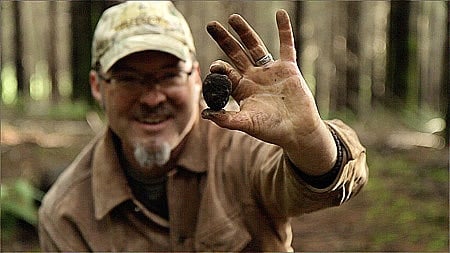
The spot near the Douglas fir clearly had drawn the attention of some digging animal in the recent past. Hmmmm… Good place to seek our quarry. I gently raked the duff away from the base of the tree and a lump fell out. I gasped involuntarily and dropped to my knees.

There it was, for all the world looking like a lump of coal. But this was no clod of earth or chip of anthracite. It was an Oregon black truffle the size of a small egg. No, definitely not coal. More like a diamond.
Finally, after hours of fruitless digging, I had found what we were looking for, leucangia carthusiana, the Oregon black truffle. At more than $300 a pound, the allusion to a diamond is not that far off. Even though that’s five times cheaper than European black truffles, it’s still enough to make this delicacy beyond my reach.
That is, until Jack Czarnecki invited me up to Oregon to chase the elusive truffle. Czarnecki may be the world’s leading expert on the culinary aspects of Oregon truffles, and he is the maker of what I consider the finest truffle oil anywhere.
Truffles, both black and white, are among the world’s great ingredients, and are a food that evokes the carnal more than anything except, perhaps, chocolate. A truffle’s secret isn’t its good looks, which range from a turd in the case of black truffles to a dirty snowball in the case of whites.
Nope, the secret to the truffle’s vaunted sex appeal is its aroma. Every variety of truffle wears a different cologne, and arguments rage over whether the white or black truffle possesses the most captivating scent — and while some say the European truffles are vastly superior to our Oregon truffles, I would politely disagree. I’ve had the pleasure of them all, and put the Oregon white truffle at the top of the list; this is the truffle Czarnecki uses to make his oil.
Jack and I would hunt for both kinds this weekend, and I was getting more and more excited as I drove north past the Cascades and up through the Willamette Valley to Czarnecki’s home in Dundee. Every time I get the chance to search for, learn about and play with a new ingredient — especially a wild ingredient — I dance a little dance inside my head. North America is home to so many world-class native foods, and these truffles are among the finest.
We woke early that first morning to head out to Jack’s black truffle spot. Apparently all truffles live under fir trees, but black truffles like older firs while white truffles prefer younger ones. When we arrived, the forest was breathtaking, ancient-looking even though it was a stand of second-growth trees. It looked like something a velociraptor might live in. Or a truffle.
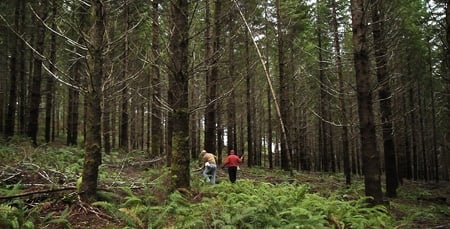
You hunt truffles by looking around the bases of the trees for signs that a squirrel or other critter has dug there recently. Squirrels love truffles even more than they do nuts, and will often chew up the ground where truffles grow to the point where you can see it.
You then take a garden rake and gently scrape at the duff to reveal the chocolate-colored soil beneath. Most times you are greeted by nothing, or maybe a curled-up centipede. But every so often, you spot a darker dark in the duff, a glint, or a sheen of something different. No matter how many truffles I found, this moment never got old: Every time, I literally fell to my knees to get close to the truffle, which would be embedded in the soil. Every time, I’d carefully, carefully remove the soil around the truffle — the same way a paleontologist removes the rock from the fossil of a velociraptor — hoping, praying that the truffle would be large.
Some black truffles are mere peanuts. Most are the size of a jawbreaker candy. A few are the size of golf balls, eggs or, once in Jack’s experience, a softball. Truffle hunting is a tantalizing combination of archaeology, panning for gold, raking a garden bed — and shopping at the finest gourmet market in the world. It is a rush of the highest order.
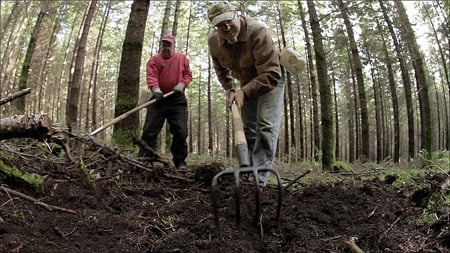
Jack and I wound up with maybe 20 or so black truffles apiece, and Jack’s friend Dick turned out to be high digger with at least 40 of the black diamonds. He’s been wanting to slice some black truffles thinly, then slip them under the skin of a chicken headed to the oven. It’s a classic truffle dish, and I plan to do it with a pheasant, or, better yet, a ruffed grouse — the king of forest game birds marries the king of forest mushrooms.
Wet, a little cold, and a lot happy, Jack and I headed from the woods to his restaurant, the Joel Palmer House, where his son Chris served us a fine mushroom-based meal that ranged from a candy cap martini to a rich mushroom tart to a shockingly good matsutake chowder; I say shockingly because it was a cream-based chowder, and I’d never liked matsutake mushrooms with cream before that night.
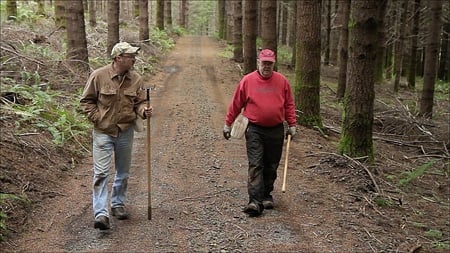
One of the topics of the dinner’s conversation was the next day’s hunt, which would be for white truffles. “Oh, you’re going to love white truffle hunting,” Jack said. He said finding whites was far easier, and the rush was less of pure discovery than it was of something else. Exactly what he did not say.
Morning came and we headed back out into the woods, this time a far younger and less wild stand of fir trees. Jack handed me a rake and we walked into the gloom of the understory. Day turned to twilight as we began moving duff around. White truffles are very close to the surface, Jack said, so be even more careful when raking.
He was right. He was also right about white truffles being easier to find than black ones. Where it took me nearly two hours to find my first black truffle, it took me less than two minutes to find my first white one.

Thank heaven white truffles are white. I have no idea how many black truffles I unearthed but never saw — spotting black truffle on dark chocolate earth is no easy feat. But I did not miss many white ones, which shone like an apparition in the gloom.
Soon I began to accumulate truffles, one after another.

Then I realized what Jack had meant by saying that white truffles provide a different rush. Discovery was easy. This high was all about greed. Several times Jack stood up with a half dollar-sized truffle and said, “More! I want more!” He was only half-joking. I soon surpassed my total haul of black truffles from the previous day. But I wanted more. I wanted to fill the milk jugs we used to hold the bounty.
I found myself locked in the grips of a full-on greed high. “How many pounds would it take to fill this jug?” I asked Jack. He said about four. Four pounds. More than $1,200 worth of truffles. Now I know the pull this feeling has on gold miners, crab fishermen, Gollum. It becomes all-encompassing, filling your mind. We raked and raked for what seemed like — and was, in fact — hours.
Somehow I finally came to my senses. Maybe it was the croak of the raven sitting bemused in the tree above me. Ravens are most sensible birds, after all. Maybe through all those croaks I finally heard it saying, “enough.” I looked at my jug. Almost exactly half-full. Enough.
Time to cook. Fresh truffles, it seems, rarely possess the aroma we all lust after. They must be washed, then carefully dried and stored in the fridge to cure. Only after several days, sometimes weeks even, will they reach their full bloom. Thankfully, Jack had some already ready at his restaurant.
I told him I wanted to recreate one of the great eating experiences of my life, a white truffle risotto I’d eaten at a little restaurant on Long Island, many years ago. That dish had been covered in slivers of Alba white truffles. The aroma of that rice still haunts me.
So I made a very basic risotto, with butter and white wine and a little Parmigiano cheese. Right at the end I stirred in Jack’s truffle oil, then shaved white truffles all over the rice.
I took a bite. Creamy, rice firm yet yielding, rich with butter and oil and cheese tempered ever so slightly by the acidity of an Oregon Pinot Blanc, the truffle slices dancing feathers on my tongue. I inhaled. God, the aroma! Funky, garlicky, floral. It reminded me of the sweat of a woman. So good, so simple, so worth every effort to make. I ate the rest of the plate eyes shut, without speaking.
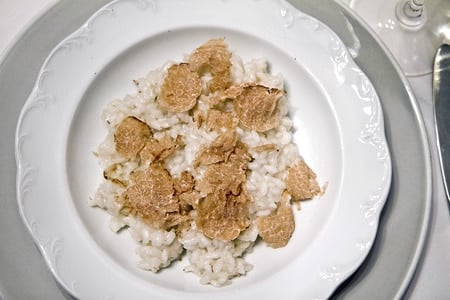
MORE ON OREGON TRUFFLES
- Langdon Cook of Fat of the Land hunts truffles with Jack
- Jack Czarnecki’s Truffle Oil Website



